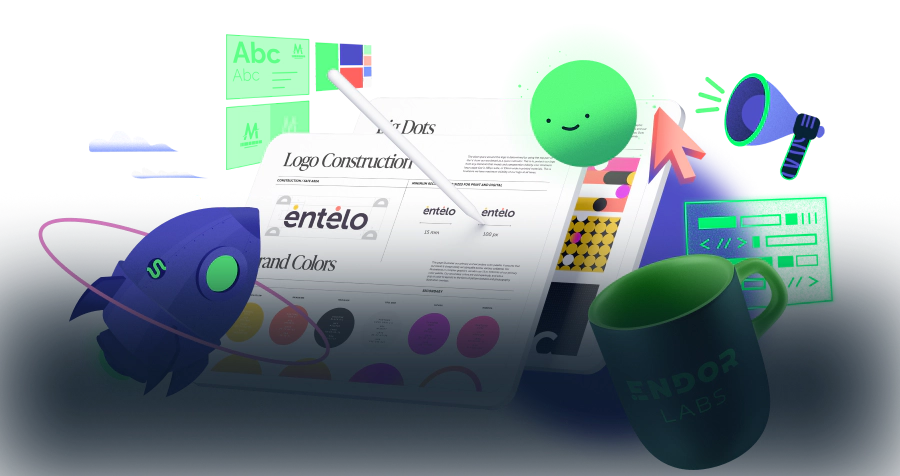
Typography, often overlooked, is a critical element in branding that transcends mere aesthetics. It is the art and science of arranging type, making content not only legible but also emotionally resonant.
Each typographic choice, from font family to spacing and color, narrates a brand's story. This silent communicator can either elevate a brand to iconic status or render it forgettable. As we navigate the nuances of typography's influence on branding, we'll explore its transformative power in crafting and solidifying a brand's identity.
Typography's Role in Branding
Consistency: Typography plays a key role in creating consistency across a brand's various platforms and materials.
A consistent typeface ensures that every time a customer receives the same experience every time they interact with a brand. This uniformity fosters trust and establishes a strong brand identity.
Recognition: Unique and consistent typography makes a brand instantly recognizable. Every time you see that Coca-Cola script or the sleek Apple typeface, you instantly know the brand behind it. That instant recognition, built over time, is immensely powerful in crowded marketplaces. Typography serves as an immediate brand identifier, often even before the actual brand name is processed.
Emotion: Typography has the power to evoke emotion. The curves, weight, and spacing of letters can convey a brand's personality – be it playful, serious, modern, or traditional. Choosing the right typeface can tap into a customer's emotions, establishing a deeper connection.
Iconic Brand Fonts and Their Impact
Typography, while sometimes overlooked, plays a significant role in the branding strategies of many global giants. Their choice of font not only complements their brand but becomes a hallmark of their identity. Here's a closer look at a few iconic brands and how their typography choices have shaped their image:
1. Coca-Cola: The Signature Spencerian Script
When one thinks of Coca-Cola, the mind immediately pictures its signature Spencerian script that has graced its logo for over a century. This cursive script evokes feelings of tradition, comfort, and nostalgia. Its flowing letters give a sense of joy and celebration, aligning perfectly with the brand's positioning as a beverage that brings happiness. The choice of this typeface wasn't merely a design whim; it's an emblematic representation of the brand's history and the emotions it aims to evoke.
2. Apple: The Sleek San Francisco Font
Apple, known for its cutting-edge design and innovation, has chosen the San Francisco font for its branding. Sleek, modern, and versatile, the San Francisco font aligns seamlessly with Apple's brand ethos of simplicity meets sophistication. Its adaptability across different devices, from watches to computers, showcases Apple's commitment to providing a seamless user experience, regardless of the platform.
3. Disney: The Whimsical Logo Font
Disney's logo, with its distinctive and whimsical font, instantly transports many to their childhood, filled with tales of magic, adventure, and wonder. The curvy, playful design of the letters, coupled with the iconic castle backdrop, solidifies its brand promise of being "The Happiest Place On Earth."
The font mirrors the enchantment and imagination that Disney offers, whether through its theme parks, movies, or merchandise. The nostalgic feel it provides ensures a deep emotional connection with audiences across generations.
In all these instances, typography goes beyond mere design. It becomes a strategic tool, cementing a brand's message and its promise. These iconic brands have leveraged the power of typography to create strong, lasting bonds with their audiences. Their fonts have become so integral that even without the accompanying logos or images, the mere sight of the typography evokes the brand's essence. Such is the profound impact of well-chosen typefaces in the world of branding.
Common Mistakes in Branding Typography
Over-Complication or Inconsistency
Over-complicating typography or inconsistency in font choices can confuse consumers and dilute brand identity. This confusion can detract from the overall message and make a brand feel unprofessional.
Choosing Fonts That Don't Align with the Brand Message
Selecting a font that doesn't align with a brand's personality or message can send mixed signals. For example, using a whimsical font for a serious financial institution might create dissonance in the viewer's mind.
Neglecting Adaptability Across Various Platforms
A failure to ensure that fonts adapt well across various platforms can lead to a fragmented brand image. Brands must choose typography that remains cohesive whether viewed on a billboard, smartphone, or web page.
Tips for Choosing the Right Typography for a Brand
Typography plays a critical role in conveying a brand's personality, values, and objectives. Selecting the right typography can elevate a brand's image, ensuring it stands out and resonates with its target audience. Here are expanded tips to guide your font selection:
1. Know Your Brand Personality
Understanding your brand's personality is fundamental. Whether your brand is formal, playful, modern, or classic, the typography you choose should reflect this.
- Formal Brands: Consider using serif fonts, which have decorative tails and edges, such as Times New Roman or Georgia. These often convey tradition, reliability, and respectability.
- Playful Brands: Handwritten or fun sans-serif fonts like Comic Neue or Lobster can be considered. They evoke a casual, friendly vibe.
- Modern Brands: Sleek, clean, sans-serif fonts like Helvetica, Arial, or Futura might be more suitable. They portray simplicity and modernity.
- Classic Brands: Typefaces like Baskerville or Garamond, which have been around for centuries, can evoke a sense of timelessness and heritage.
2. Prioritize Readability
While decorative fonts might look appealing, it's essential that your audience can quickly and effortlessly read the content. Ensure that the typeface you choose is legible across all platforms and sizes. This includes considering the font's x-height, kerning, and letter spacing.
3. Limit Font Usage
While it's tempting to use various fonts, it's best practice to stick to 2-3 fonts. Use them consistently across different aspects of your branding. This could be one for headers, one for body text, and possibly a decorative one for specific highlights or calls to action. This ensures consistency, aids readability, and avoids a cluttered design.
4. Avoid Overused Fonts
While certain fonts might have gained popularity for a period, they can quickly become overused and associated with amateur designs. Fonts like Comic Sans or Papyrus were popular at one point, but using them now could make your brand appear unprofessional and out-of-date. It's essential to keep a pulse on design trends and ensure your typography choices remain fresh and relevant.
5. Test Across Platforms
In our digital age, consumers will interact with your brand on a myriad of platforms. Ensure that your chosen typography looks and functions well both in print and digitally. This is especially crucial for mobile devices, where screen space is limited, and readability becomes even more paramount.
Conclusion
Typography is more than just words on a page or screen. It's an essential tool in a brand's toolkit, capable of conveying personality, emotion, and values without saying a word. By understanding its importance and implementing it wisely, brands can ensure they remain etched in the minds and hearts of their customers.






